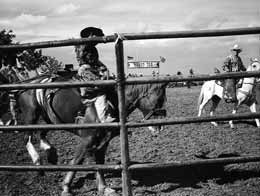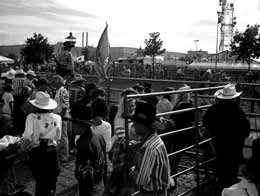
 "...
landscape Germany is not as large as Texas, but it has a varied landscape
and climate. The terrain is rugged, generally speaking, with extensive
wooded areas. Central Germany has low mountains resembling the Catskills
or the Blue Ridge. These mountains extend into southern Germany where
the Black Forest spreads into Baden and Wuerttemberg. At the southern
border of Germany, the Alps rise to eight or nine thousand feet. the
country is crossed by a few major rivers: the west is drained by the
Rhine; in the central and northern parts are the Weser and the Elbe;
in the east flows the Oder; in the south the Danube. Low plains with
wide pastures and fields of rye, wheat, oats and potatoes cover northern
Germany, similar to our Midwest. Many Germans and many foreigners like
to think of Germany as a land covered with quaint old towns set in the
midst of an agricultural country. This of course is not so. Germany during
the last seventy years, has become one of the leading industrial countries
in the world, producing iron and coal, machinery, textiles, optical instruments,
and chemical products. Some of these industries are scattered over the
greater part of Germany, but many are concentrated in thickly congested
industrial districts; for example, the Ruhr area, reaching from the Rhine
to Dortmund; mines, smokestacks and furnaces dominate this landscape.
Climate The climate of Germany resembles that of the eastern seaboard
of the United States in the region of Baltimore and Washington. As at
home, the four seasons are sharply defined. Except in some of the mountain
regions, Germans do not experience the extreme of winter cold that we
do in the northern United States. Winter is liable to have penetrating
dampness rather than severe
"...
landscape Germany is not as large as Texas, but it has a varied landscape
and climate. The terrain is rugged, generally speaking, with extensive
wooded areas. Central Germany has low mountains resembling the Catskills
or the Blue Ridge. These mountains extend into southern Germany where
the Black Forest spreads into Baden and Wuerttemberg. At the southern
border of Germany, the Alps rise to eight or nine thousand feet. the
country is crossed by a few major rivers: the west is drained by the
Rhine; in the central and northern parts are the Weser and the Elbe;
in the east flows the Oder; in the south the Danube. Low plains with
wide pastures and fields of rye, wheat, oats and potatoes cover northern
Germany, similar to our Midwest. Many Germans and many foreigners like
to think of Germany as a land covered with quaint old towns set in the
midst of an agricultural country. This of course is not so. Germany during
the last seventy years, has become one of the leading industrial countries
in the world, producing iron and coal, machinery, textiles, optical instruments,
and chemical products. Some of these industries are scattered over the
greater part of Germany, but many are concentrated in thickly congested
industrial districts; for example, the Ruhr area, reaching from the Rhine
to Dortmund; mines, smokestacks and furnaces dominate this landscape.
Climate The climate of Germany resembles that of the eastern seaboard
of the United States in the region of Baltimore and Washington. As at
home, the four seasons are sharply defined. Except in some of the mountain
regions, Germans do not experience the extreme of winter cold that we
do in the northern United States. Winter is liable to have penetrating
dampness rather than severe  cold.
Snow does not remain upon the ground long, except in the mountains. In
the Alpine regions, the winters are severe with heavy snowfall. The mean
temperatures in the summertime do not range as high as do ours at home,
but humidity may be high and in the northern part of Germany you may
run into hot, sticky, enervating days. ..." So far the more touristy
informations taken from a small booklet I found in the bookstore of the
"Haus der Geschichte" (The House of History) in Bonn, Germany. The "Haus
der Geschichte" is an extremely well attended institution, especially
by German and international school classes, as well as by large tourist
groups and soldiers from the U.S. Army serving in Germany. The Museum's
objective is to create an impression of how Germany has developed and
changed since 1945. As mentioned on the Museum's website (www.hdg.de)
its aim is to provide the public "both at home and abroad with an unambiguous
portrayal of the historical evolution of democratic tradition" and "to
provide a stimulus not only for a candid approach to history but also
for controversial discussion." The "Haus der Geschichte" is conceived
as a museum of contemporary history; that is, it traces the progress
of history in what is necessarily an "open end" process. Thus the permanent
exhibition (original displays of documents, photographs and objects)
has to be redesigned at relatively short intervals in order to update
both its content and its appearance. The Museum also publishes a Magazine
and from time to time reprints historical documents and "forgotten" documentations,
in small numbers. One of these publications is the "Pocket Guide to Germany",
a 48 pages thin booklet (11,8 x 13,2 cm), first printed in 1944 by the
U.S. Government Printing Office, prepared by the Army Information Branch.
Apart from informations about landscape and climate, the booklet gives
further practical hints in respect to Health questions, all about Marriage
facts and a very amusing Language Guide (+ hints on pronunciation) in
the Annex. Nevertheless it is definetly not a tourist guide. The biggest
part of it contains special information and orders for soldiers about
how to behave, how to act, how to answer questions and how to function
as an example (as well as the definite order not to fraterinze). The
chapters Keep your distance and Keep your guard up warn off not to trust
the young Germans who had been taught "that the strong are entitled to
pick on and destroy the weak, that it is noble to squeal on a pal, or
even snitch on a member of one's own family ". On the other hand there
is expressed a lot of understanding for the enemy who is also regarded
as a "victim of the greatest educational crime in the history of the
world". It is this kind of double- description which makes the booklet
exciting. There is left no doubt about who started World War II, and
all the other Wars in Europe since 1864 (A glimpse of history), and that
it is going to take a long time for Germany to find a way back into the
community of civilized nations. Furthermore there are given clear instructions
for how to deal with the enemy's attitude. The chapter ALIBIS contains
a catalogue of answers for the most common questions, lies and errors
of the Germans and at the same time the recommendations: "Don't argue
with them. Don't try to convince them. Don't get angry. Give them the
- Okay-chum- you'll- find-out- soon-enough treatment and walk away. Help
to create a genuine longing and thirst for the truth and real news in
the German people," . The "Pocket Guide to Germany" can be ordered at
the "Haus der Geschichte". Martin Brandt (all quotes: "Pocket Guide to
Germany")
cold.
Snow does not remain upon the ground long, except in the mountains. In
the Alpine regions, the winters are severe with heavy snowfall. The mean
temperatures in the summertime do not range as high as do ours at home,
but humidity may be high and in the northern part of Germany you may
run into hot, sticky, enervating days. ..." So far the more touristy
informations taken from a small booklet I found in the bookstore of the
"Haus der Geschichte" (The House of History) in Bonn, Germany. The "Haus
der Geschichte" is an extremely well attended institution, especially
by German and international school classes, as well as by large tourist
groups and soldiers from the U.S. Army serving in Germany. The Museum's
objective is to create an impression of how Germany has developed and
changed since 1945. As mentioned on the Museum's website (www.hdg.de)
its aim is to provide the public "both at home and abroad with an unambiguous
portrayal of the historical evolution of democratic tradition" and "to
provide a stimulus not only for a candid approach to history but also
for controversial discussion." The "Haus der Geschichte" is conceived
as a museum of contemporary history; that is, it traces the progress
of history in what is necessarily an "open end" process. Thus the permanent
exhibition (original displays of documents, photographs and objects)
has to be redesigned at relatively short intervals in order to update
both its content and its appearance. The Museum also publishes a Magazine
and from time to time reprints historical documents and "forgotten" documentations,
in small numbers. One of these publications is the "Pocket Guide to Germany",
a 48 pages thin booklet (11,8 x 13,2 cm), first printed in 1944 by the
U.S. Government Printing Office, prepared by the Army Information Branch.
Apart from informations about landscape and climate, the booklet gives
further practical hints in respect to Health questions, all about Marriage
facts and a very amusing Language Guide (+ hints on pronunciation) in
the Annex. Nevertheless it is definetly not a tourist guide. The biggest
part of it contains special information and orders for soldiers about
how to behave, how to act, how to answer questions and how to function
as an example (as well as the definite order not to fraterinze). The
chapters Keep your distance and Keep your guard up warn off not to trust
the young Germans who had been taught "that the strong are entitled to
pick on and destroy the weak, that it is noble to squeal on a pal, or
even snitch on a member of one's own family ". On the other hand there
is expressed a lot of understanding for the enemy who is also regarded
as a "victim of the greatest educational crime in the history of the
world". It is this kind of double- description which makes the booklet
exciting. There is left no doubt about who started World War II, and
all the other Wars in Europe since 1864 (A glimpse of history), and that
it is going to take a long time for Germany to find a way back into the
community of civilized nations. Furthermore there are given clear instructions
for how to deal with the enemy's attitude. The chapter ALIBIS contains
a catalogue of answers for the most common questions, lies and errors
of the Germans and at the same time the recommendations: "Don't argue
with them. Don't try to convince them. Don't get angry. Give them the
- Okay-chum- you'll- find-out- soon-enough treatment and walk away. Help
to create a genuine longing and thirst for the truth and real news in
the German people," . The "Pocket Guide to Germany" can be ordered at
the "Haus der Geschichte". Martin Brandt (all quotes: "Pocket Guide to
Germany")